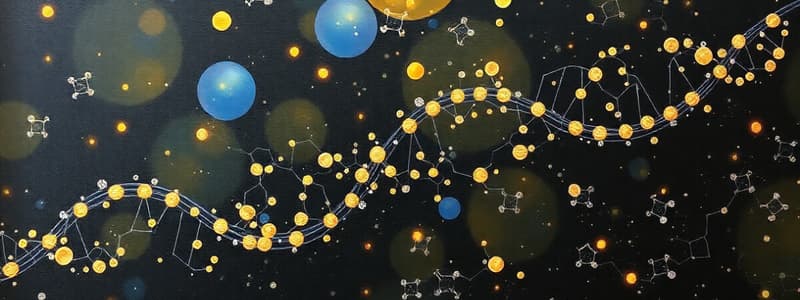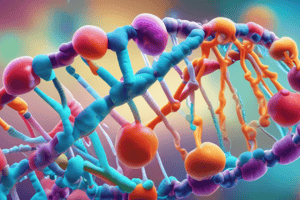Podcast
Questions and Answers
Which of the following best describes the primary function of DNA?
Which of the following best describes the primary function of DNA?
- Acting as the main energy currency of the cell.
- Storing genetic information. (correct)
- Catalyzing metabolic reactions within the cell.
- Providing a template for protein synthesis.
If a scientist identifies a molecule containing a pentose sugar, phosphate group, and a nitrogenous base, which of the following could it be?
If a scientist identifies a molecule containing a pentose sugar, phosphate group, and a nitrogenous base, which of the following could it be?
- A nucleotide, the building block of nucleic acids. (correct)
- A protein composed of amino acids.
- A monosaccharide like glucose or fructose.
- A lipid such as a triglyceride.
Which nitrogenous base is unique to RNA and not found in DNA?
Which nitrogenous base is unique to RNA and not found in DNA?
- Thymine
- Adenine
- Uracil (correct)
- Cytosine
What is the role of ATP within a cell?
What is the role of ATP within a cell?
Which of the following pairings correctly matches a nitrogenous base with its classification as a purine or pyrimidine?
Which of the following pairings correctly matches a nitrogenous base with its classification as a purine or pyrimidine?
Flashcards
Carbohydrates
Carbohydrates
Organic compounds including sugars, starches, and fibers, providing energy for the body.
Proteins
Proteins
Organic compounds composed of amino acids, essential for building and repairing tissues.
Lipids
Lipids
Organic compounds including fats and oils, used for energy storage, insulation, and hormone production.
Nucleic Acids
Nucleic Acids
Organic compounds composed of a pentose sugar, phosphate group, and nitrogenous base and carries genetic information
Signup and view all the flashcards
DNA
DNA
Deoxyribonucleic acid, a molecule that carries genetic information, used in the development and functioning of all known living organisms.
Signup and view all the flashcardsStudy Notes
- Organic compounds include carbohydrates, proteins, lipids (fats and oils), and nucleic acids
Nucleic Acids
- Nucleic acids are composed of a pentose sugar, a phosphate group, and a nitrogen base
- Nitrogen bases are categorized into purines and pyrimidines
Purines
- Purines include adenine (A) and guanine (G)
Pyrimidines
- Pyrimidines include cytosine (C), thymine (T), and uracil (U)
DNA
- DNA is deoxyribonucleic acid
- DNA stores genetic information
RNA
- RNA is ribonucleic acid
ATP
- ATP serves as the cell's energy source
Studying That Suits You
Use AI to generate personalized quizzes and flashcards to suit your learning preferences.




